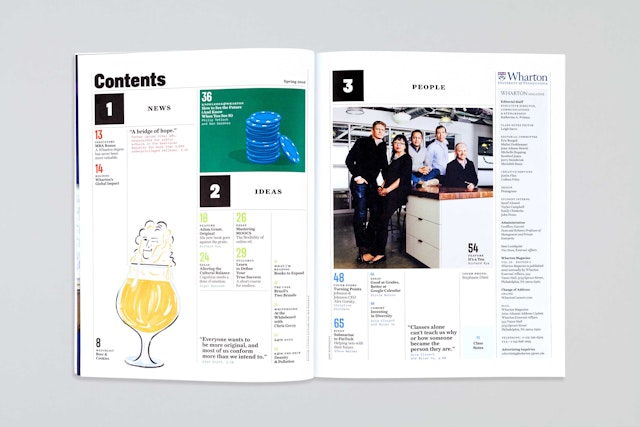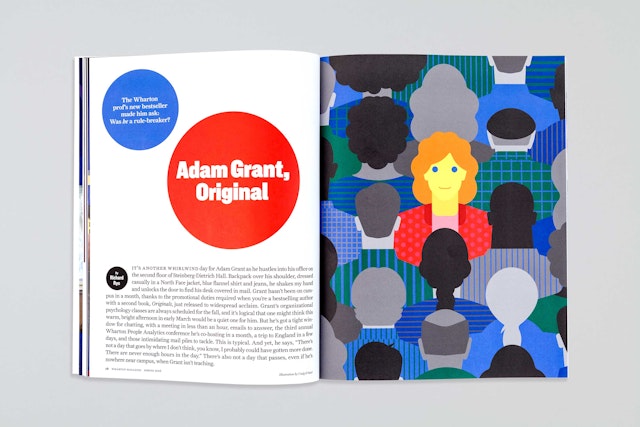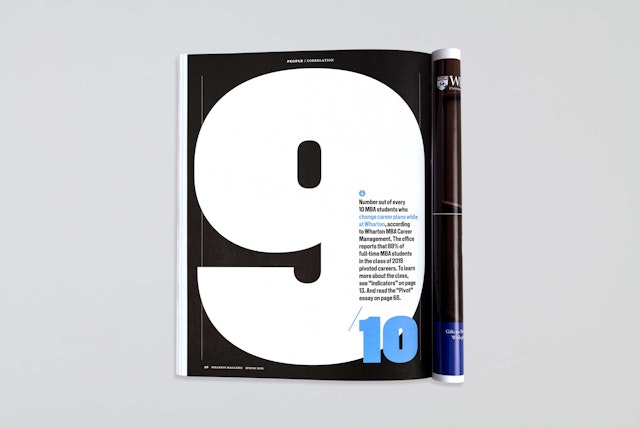






Short, quick bits of data are mixed with longer reads and a structured but flexible grid opens up the pages in clean, clear layouts that let the content breathe.











Founded in 1881 as the first collegiate business school in the world, the Wharton School of the University of Pennsylvania is renowned for producing visionary leaders across all spheres of business, with notable alumni that include Elon Musk, Ronald Perelman, Laurence Tisch, Leonard Lauder, Warren Buffett (who dropped out before graduating), and many more. This year the school relaunched its alumni publication, Wharton Magazine, with a new design by Pentagram that helps bring the groundbreaking ideas of the school’s graduates to the fore.
The redesign was an initiative of Wharton’s new leadership, including Dean Geoffrey Garrett and Katherine A. Primus, the new Executive Director of Communications and Stewardship. For strategy, Pentagram joined forces with Jay Heinrichs, an editorial consultant who has worked extensively with schools on publications. The team worked to restructure the magazine by thinking about what Wharton is, and what it can be. The institution has a formidable reputation for strength in banking and finance that can eclipse it being seen as a center of innovation. Wharton wanted the magazine to foster a more accurate and progressive representation, one that showcased the entrepreneurial spirit of its graduates and did not exclude the school from the startup and innovation economy.
Wharton also wanted a magazine that looked and felt worthy of its distinguished alumni. The existing format was dense with information but seemed thin and somewhat generic. The team wanted to create something more substantial—a magazine that felt like it should be read, and possibly kept, on par with other titles its alumni might subscribe to, like The Economist and The Atlantic.
The dimensions of the redesigned magazine have been reduced slightly to 8″ by 10″, an elegant and easy-to-handle size that helps it feel like a journal. The binding has been switched from saddle-stitch to perfect bound, giving the issues more of a presence, and the magazine is now printed on uncoated paper that is more tactile and inviting for readers to leaf through its pages.
Inside, the focus of the content has been sharpened to emphasize the personalities and ideas behind the school. The magazine has been reorganized into three distinct sections that each offer a look at alumni activity through the lens of thought leadership: “News,” front-of-book updates, including the Watch List, a roundup of current ventures by Wharton graduates; “Ideas,” longer pieces that spotlight innovation; and “People,” which includes profiles, followed by the back-of-book alumni class notes. The print magazine also integrates content from Knowledge@Wharton, the school’s online business analysis journal with 1.8 million subscribers worldwide.
The new design strikes a balance between traditional and contemporary. Short, quick bits of data are mixed with longer reads and a structured but flexible grid opens up the pages in clean, clear layouts that let the content breathe. Throughout, greater use of illustration, photography and infographics are used to create a varied and vibrant presentation that reflects the wide-ranging Wharton experience. (The designers worked with consulting photo editors Stauss & Quint to help with commissioning and to craft the image selection.) Principal typography is set in a mix of modern and classic fonts. The updated roman serif font Farnham is used for the masthead, body copy and section openers; headlines and display typography appear in the strong, wood-type inspired New Grotesk Square; and the monospaced font Nitti is used for captions, short bits and touts to the Wharton website.
The “News” section keys into the extraordinary Wharton alumni network of 92,000 graduates, spotlighting several entrepreneur-alumni to keep in an eye on in the Watch List and detailing the worldwide influence of the school in a map titled Wharton’s Global Impact. The Indicators page outlines the rewards of a Wharton degree in an infographic of job stats from the MBA class of 2015. A ticker-like run of news bits runs along the bottom of the section pages.
Lifelong learning and the incredible knowledge base of Wharton grads are the focus of the “Ideas” section. The first issue of the relaunch includes a profile of Adam Grant, the Wharton professor who authored the bestselling book Originals: How Non-Conformists Move the World, about rule breakers in business; and incorporates material tied to Knowledge@Wharton, the school’s online business analysis journal.
In addition to the cover story about Johnson & Johnson CEO Alex Gorsky, Wharton Graduate, Class of 1984, the “People” section includes a look at how a team with a core of Wharton grads helped save revolutionize Microsoft Windows with Windows 10. The section, and magazine, concludes with Class Notes, which are printed on a shade of the signature Penn/Wharton blue.
Sector
- Education
- Publishing
- Finance
Discipline
- Publications
